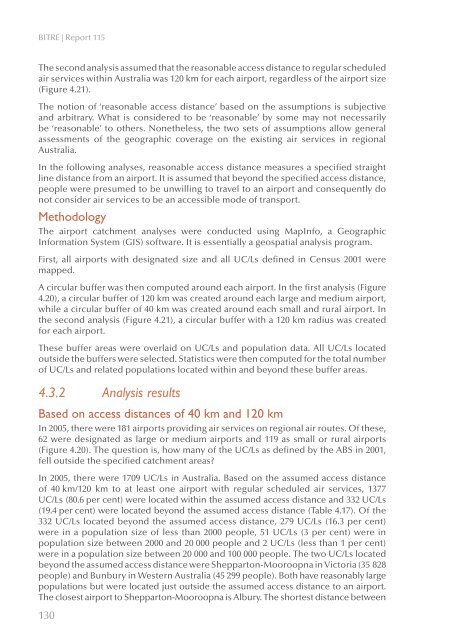PDF: 5191 KB - Bureau of Infrastructure, Transport and Regional ...
PDF: 5191 KB - Bureau of Infrastructure, Transport and Regional ...
PDF: 5191 KB - Bureau of Infrastructure, Transport and Regional ...
- No tags were found...
Create successful ePaper yourself
Turn your PDF publications into a flip-book with our unique Google optimized e-Paper software.
BITRE | Report 115The second analysis assumed that the reasonable access distance to regular scheduledair services within Australia was 120 km for each airport, regardless <strong>of</strong> the airport size(Figure 4.21).The notion <strong>of</strong> ‘reasonable access distance’ based on the assumptions is subjective<strong>and</strong> arbitrary. What is considered to be ‘reasonable’ by some may not necessarilybe ‘reasonable’ to others. Nonetheless, the two sets <strong>of</strong> assumptions allow generalassessments <strong>of</strong> the geographic coverage on the existing air services in regionalAustralia.In the following analyses, reasonable access distance measures a specified straightline distance from an airport. It is assumed that beyond the specified access distance,people were presumed to be unwilling to travel to an airport <strong>and</strong> consequently donot consider air services to be an accessible mode <strong>of</strong> transport.MethodologyThe airport catchment analyses were conducted using MapInfo, a GeographicInformation System (GIS) s<strong>of</strong>tware. It is essentially a geospatial analysis program.First, all airports with designated size <strong>and</strong> all UC/Ls defined in Census 2001 weremapped.A circular buffer was then computed around each airport. In the first analysis (Figure4.20), a circular buffer <strong>of</strong> 120 km was created around each large <strong>and</strong> medium airport,while a circular buffer <strong>of</strong> 40 km was created around each small <strong>and</strong> rural airport. Inthe second analysis (Figure 4.21), a circular buffer with a 120 km radius was createdfor each airport.These buffer areas were overlaid on UC/Ls <strong>and</strong> population data. All UC/Ls locatedoutside the buffers were selected. Statistics were then computed for the total number<strong>of</strong> UC/Ls <strong>and</strong> related populations located within <strong>and</strong> beyond these buffer areas.4.3.2 Analysis resultsBased on access distances <strong>of</strong> 40 km <strong>and</strong> 120 kmIn 2005, there were 181 airports providing air services on regional air routes. Of these,62 were designated as large or medium airports <strong>and</strong> 119 as small or rural airports(Figure 4.20). The question is, how many <strong>of</strong> the UC/Ls as defined by the ABS in 2001,fell outside the specified catchment areas?In 2005, there were 1709 UC/Ls in Australia. Based on the assumed access distance<strong>of</strong> 40 km/120 km to at least one airport with regular scheduled air services, 1377UC/Ls (80.6 per cent) were located within the assumed access distance <strong>and</strong> 332 UC/Ls(19.4 per cent) were located beyond the assumed access distance (Table 4.17). Of the332 UC/Ls located beyond the assumed access distance, 279 UC/Ls (16.3 per cent)were in a population size <strong>of</strong> less than 2000 people, 51 UC/Ls (3 per cent) were inpopulation size between 2000 <strong>and</strong> 20 000 people <strong>and</strong> 2 UC/Ls (less than 1 per cent)were in a population size between 20 000 <strong>and</strong> 100 000 people. The two UC/Ls locatedbeyond the assumed access distance were Shepparton-Mooroopna in Victoria (35 828people) <strong>and</strong> Bunbury in Western Australia (45 299 people). Both have reasonably largepopulations but were located just outside the assumed access distance to an airport.The closest airport to Shepparton-Mooroopna is Albury. The shortest distance between130
















